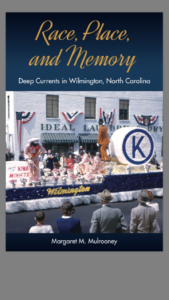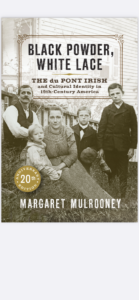Race, Place, and Memory: Deep Currents in Wilmington, North Carolina came out in Jan. 2018 from University of Florida Press. Now out in paperback.
“Simply put, in cultural, political, and social environments rife with debates and disputes regarding Confederate-themed commemorative and celebratory statues and monuments in public venues, Mulrooney’s book deserves wide attention. . . . Essential.” — CHOICE
“A well-researched and well-documented must-read for anyone interested in the history of race and place, and it provides an invaluable resource for understanding Wilmington.”—Journal of American History
“Recommended reading for anyone who wants to understand the importance and power of public history in creating a usable past.”—Journal of Southern History
“An immensely welcome longitudinal study of the intersection of race, place, and historical memory in Wilmington, North Carolina. Richly researched, beautifully written, and deeply analytical, Mulrooney’s study is a tour de force.”–John David Smith, editor of Interpreting American History: Reconstruction
“With clear and compelling prose, Mulrooney dives beneath the seemingly calm waters of a ‘progressive city’ to find evidence that racialized violence and memory-making were foundational to southern settlement and development rather than a mere aberration.”–Derek H. Alderman, coauthor of Civil Rights Memorials and the Geography of Memory
 A revealing work of public history that shows how communities remember their pasts in different ways to fit specific narratives, Race, Place, and Memory charts the ebb and flow of racial violence in Wilmington, North Carolina, from the 1730s to the present day.
A revealing work of public history that shows how communities remember their pasts in different ways to fit specific narratives, Race, Place, and Memory charts the ebb and flow of racial violence in Wilmington, North Carolina, from the 1730s to the present day.
Margaret Mulrooney argues that white elites have employed public spaces, memorials, and celebrations to maintain the status quo. The port city has long celebrated its white colonial revolutionary origins, memorialized Decoration Day, and hosted Klan parades. Other events, such as the Azalea Festival, have attempted to present a false picture of racial harmony to attract tourists. And yet, the revolutionary acts of Wilmington’s African American citizens—who also demanded freedom, first from slavery and later from Jim Crow discrimination—have gone unrecognized. As a result, beneath the surface of daily life, collective memories of violence and alienation linger among the city’s black population.
Mulrooney describes her own experiences as a public historian involved in the centennial commemoration of the so-called Wilmington Race Riot of 1898, which perpetuated racial conflicts in the city throughout the twentieth century. She shows how, despite organizers’ best efforts, a white-authored narrative of the riot’s contested origins remains. Mulrooney makes a case for public history projects that recognize the history-making authority of all community members and prompts us to reconsider the memories we inherit.
Buy the book from University Press of Florida:
http://upf.com/book.asp?id=9780813054926
****************************
Black Powder, White Lace: the du Pont Irish and Cultural Identity in Nineteenth Century America (2001; 2nd ed. forthcoming 2022 University of Delaware Press).
Twentieth Anniversary edition on order now. Hard to believe!
Twenty years ago, Margaret Mulrooney’s history of the community of Irish immigrant workers at the du Pont powder yards, Black Powder, White Lace, was published to wide acclaim. Now, as much of the materials Mulrooney used in her research are now electronically available to the public, and as debates about immigration continue to rage, a new edition of the book is being published to remind readers of the rich materials available on the du Pont workers, and of Mulrooney’s powerful conclusions about immigrant communities in America.
The powder mill community built by the Irish is no more, but the site is interpreted to the public as part of Hagley Museum and Library. Hagley is developing a companion website containing digitized copies of many of the du Pont company records I used in the book.
In 2014, I gave an invited lecture at Hagley based on Black Powder, White Lace. A video recording can be found here: https://www.hagley.org/librarynews/video-black-powder-white-lace-du-pont-irish-and-cultural-identity-nineteenth-century
*****************
Fleeing the Famine: North America and Irish Refugees, 1845-1851 (2003)
The Irish Potato Famine caused the migration of more than two million individuals who sought refuge in the United States and Canada. In contrast to previous studies, which have tended to focus on only one destination, this collection allows readers to evaluate the experience of transatlantic Famine refugees in a comparative context. Featuring new and innovative scholarship by both established and emerging scholars of Irish America and Irish Canada, it carefully dissects the connection that arose between Ireland and North America during the famine years (1845-1851).
In the more than 150 years since the onset of Ireland’s Great Famine, historians have intensely scrutinized the causes, the year-by-year events, and the consequences of his human catastrophe. Who was to blame? Were the hunger and misery inevitable? Did the famine have revolutionary effects on the Irish economy? How did it change the nature of Irish religion? This new study complements the wealth of existing literature on the social, cultural, and political aspects of the Famine and invites the reader to consider the fate of the Irish refugees in their new home lands.
**********************
A Legacy of Coal: The Coal Company Towns of Southwestern Pennsylvania
Historic American Buildings Survey/Historic American Engineering Record
